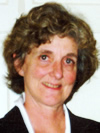 Gail M. Ashley |
2012 Laurence L. Sloss Award
Presented to Gail M. Ashley
Citation by Steven G. Driese
Gail Ashley has made original and lasting contributions to numerous areas of sedimentary geology, any one of which would qualify her for the Sloss Award.
Gail has published 91 papers in refereed journals, supervised the research of 37 graduate students, edited 6 volumes of research papers, given 5 keynote lectures at international scientific conferences, 80 invited lectures and authored or co-authored ~150 papers at professional meetings. Her career spans about 34 years. Her research is field-based and she has worked in areas ranging from the poles to the equator (Antarctica, Alaska, Canada, U.K., Ireland, New England, New Jersey and East Africa.).The common theme to her research is the application of earth surface processes (sedimentology, hydrology, and geomorphology) to interpreting the recent past (Plio-Pleistocene-Holocene) in terms of paleoenvironment and paleoclimate.
In the 1970s Gail was one of the pioneers in the application of modern sedimentological concepts to interpreting glacial deposits. In the 1980s she conducted fluid dynamics research, using flume runs at M.I.T. In the early 1990s she contributed a seminal classification of large scale bed forms, sequence stratigraphy of the Atlantic continental margin, and a number of papers on glacial sedimentology of the Brooks Range in Alaska, as well as in Ireland and Antarctica. She earned the nick name the “Varve Queen” (coined by colleague Jon Boothroyd). From the mid-1990s to the present her research has emphasized reconstruction of paleoenvironments of hominins in East Africa, including Olduvai Gorge in Tanzania and Kenya, as well as freshwater wetlands and related sites. In 1990, she developed the Quaternary Studies Graduate Certificate Program at Rutgers University, which has awarded 25 certificates, presently involves ~15 participating faculty from 5 departments, has 15 students presently enrolled, and 6 interdisciplinary courses approved by the Graduate School.
For the first 23 years of her career at Rutgers, she was the only tenured female faculty member in Geological Sciences and thus the only female to represent the department on College and University committees. During this time she served as the sole female role model and mentor for the increasing number of female students in the department. She has also served as a role model for female geoscientists at the national and international level through her leadership as an editor of premier journals such as the Journal of Sedimentary Research, as President of high-profile scientific societies including SEPM, GSA and AGI, and her leadership on NSF and NRC panels charting research directions in sedimentary geology.
I have worked closely with Gail since 1997 on research in East Africa, and cannot imagine a better colleague—or a better friend. As she has done for more than three decades, Gail Ashley continues to lead sedimentary geology in new directions. Larry Sloss would be proud were he still alive.
 2012 Laurence L. Sloss Award — Response by Gail M. Ashley
2012 Laurence L. Sloss Award — Response by Gail M. Ashley
I am very flattered and grateful to receive the Laurence L. Sloss Award from the Sedimentary Geology Division and want to thank all involved in the nomination, particularly those who wrote letters and Steve Driese for his kind words. I knew Larry Sloss, back when….he too had been president of SEPM, GSA, and AGI and did not hesitate to call me up to give advice when he thought I could use it. He called often! But, I think he would be o.k. with this award. I am very pleased.
Listening to Steve’s summary of my career, it sounded like a well-planned trajectory. It was anything but that. My career was a series of 5-year plans that zigzagged across the sedimentological landscape from the Antarctic to Africa, changing topics along the way. At the time I started, there were essentially no senior women scientists for me to take cues from; how to juggle kids, family and field work. But, I was fortunate to have many male colleagues who gave me encouragement, built my confidence and opened doors for me. Marshall Schalk (Smith College) was my next door neighbor and gave me my first book on geology and told me it was something girls could do. George Magill admitted me into grad school with a less-than-stellar academic record and, incidentally, with 2 small children. This instilled in me desperately needed self-confidence. Miles Hayes taught me the value of modern process studies and supervisors Joe Hartshorn and Bill Mathews encouraged research independence. Jon Boothroyd and Norm Smith were great role models for field work in modern environments. Tom Hamilton (USGS) relentlessly hammered home the importance of careful observations and note taking. John Southard was an inspirational guide on how to try to answer sedimentological questions with experimental studies. Richard Hay, who wrote the book on Olduvai Gorge, graciously encouraged me to take on stratigraphic and geo-archaeological research at the Gorge and shared his vast knowledge with me.
In the last four decades I have seen the gender gap in geology narrow and most programs now have ~50% women students. There remains a long way to go for parity in Earth Science faculties. Universities need to be “family friendly”, to recognize that academics are people first (not just a commodity) and have the right to a full life that includes relationships.
My career had a steep learning curve and is getting steeper. Yet, I feel I have received more from my colleagues and the 37 grad students and hundreds of undergrads, than I have contributed.
Research has always been fun for me. Varves, bed forms, pingos, eskers, tidal channels, springs, wetlands and now the Critical Zone have all been grist to my mill. I have been lucky to have the backing of my two children, Kim and Tod) during a sometimes very chaotic life. I want to particularly thank my husband Jerry; he is my reality check, my chief critic and my best friend. I would not be where I am without my family.
